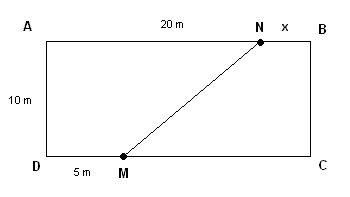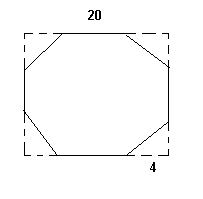Grade 7 Maths Problems
With Solutions and Explanations
Detailed solutions and full explanations to grade 7 maths problems are presented.
Problems
Problem
In a bag, \(\dfrac14\) of the balls are green, \(\dfrac18\) are blue, \(\dfrac1{12}\) are yellow, and the remaining 26 are white. How many balls are blue?
Solution
Fraction of green, blue, and yellow balls:
\[
\dfrac14 + \dfrac18 + \dfrac1{12} = \dfrac6{24} + \dfrac3{24} + \dfrac2{24} = \dfrac{11}{24}.
\]
Fraction of white balls:
\[
\dfrac{24}{24} - \dfrac{11}{24} = \dfrac{13}{24}.
\]
If \(x\) is the total number of balls, then
\[
\dfrac{13}{24}x = 26 \quad\Rightarrow\quad x = 26 \times \dfrac{24}{13} = 48.
\]
Number of blue balls:
\[
\dfrac18 \times 48 = 6.
\]
Answer: 6 balls.
-
Problem
In a school, 50% of students are younger than 10, \(\dfrac1{20}\) are 10 years old, \(\dfrac1{10}\) are older than 10 but younger than 12, and the remaining 70 students are 12 or older. How many students are 10 years old?
Solution
Fraction of Groups A, B, C:
\[
\dfrac12 + \dfrac1{20} + \dfrac1{10} = \dfrac{10}{20} + \dfrac1{20} + \dfrac2{20} = \dfrac{13}{20}.
\]
Fraction for Group D:
\[
1 - \dfrac{13}{20} = \dfrac7{20}.
\]
Since \(\dfrac7{20}X = 70\), we have \(X = 200\) students in total.
Number of 10-year-old students:
\[
\dfrac1{20} \times 200 = 10.
\]
-
Problem
If the length of a square’s side is doubled, what is the ratio of the areas of the original square to the new square?
Solution
Original area: \(x^2\). New area: \((2x)^2 = 4x^2\).
Ratio:
\[
\dfrac{x^2}{4x^2} = \dfrac14 \quad\text{or}\quad 1:4.
\]
-
Problem
The division of \(N\) by 13 gives a quotient of 15 and remainder 2. Find \(N\).
Solution
\[
N = 15 \times 13 + 2 = 197.
\]
-
Problem
In the rectangle below, line \(MN\) cuts it so that \(MNBC\) is \(40\%\) of the total area. Find \(x = NB\).

Solution
From \(MC + 5 = 20 + x\), we get \(MC = 15 + x\).
Area of trapezoid \(MNBC\):
\[
A = \dfrac12 \times 10 \times (x + MC) = 5(2x + 15).
\]
\(40\%\) of rectangle area:
\[
0.4 \times (20 + x) \times 10 = 4(20 + x).
\]
Equating:
\[
5(2x + 15) = 4(20 + x) \quad\Rightarrow\quad 10x + 75 = 80 + 4x \quad\Rightarrow\quad 6x = 5 \quad\Rightarrow\quad x = \dfrac56 \text{ m}.
\]
Problem
A person jogged 10 times along the perimeter of a rectangular field at the rate of 12 kilometers per hour for 30 minutes. If the field has a length that is twice its width, find the area of the field in square meters.
Solution
Let us first find the distance \(d\) jogged:
\[
\text{distance} = \text{rate} \times \text{time} = (12 \ \text{km/hr}) \times 0.5 \ \text{hr} = 6 \ \text{km}
\]
The distance of \(6\ \text{km}\) corresponds to \(10\) perimeters, so:
\[
\text{1 perimeter} = \dfrac{6}{10} \ \text{km} = 0.6 \ \text{km} = 600 \ \text{m}
\]
Let \(L\) and \(W\) be the length and width of the field. Given \(L = 2W\) and:
\[
2(L + W) = 600
\]
Substitute \(L = 2W\):
\[
2(2W + W) = 600 \quad \Rightarrow \quad 6W = 600 \quad \Rightarrow \quad W = 100
\]
\[
L = 2W = 200
\]
Area:
\[
A = L \times W = 200 \times 100 = 20{,}000 \ \text{m}^2
\]
Problem
Four congruent isosceles right triangles are cut from the 4 corners of a square with a side of 20 units. The length of one leg of the triangles is 4 units. What is the area of the remaining octagon?

Solution
Area of the square:
\[
A = 20 \times 20 = 400
\]
Area of one small triangle:
\[
B = \dfrac{1}{2} \times 4 \times 4 = 8
\]
Area of the octagon:
\[
A - 4B = 400 - 4 \times 8 = 368
\]
Problem
A car is traveling 75 kilometers per hour. How many meters does the car travel in one minute?
Solution
\[
75 \ \text{km/hr} = \dfrac{75 \times 1000 \ \text{m}}{60 \ \text{min}} = 1250 \ \text{m/min}
\]
Problem
Linda spent \(\dfrac{3}{4}\) of her savings on furniture and the rest on a TV. If the TV cost her \$200, what were her original savings?
Solution
Fraction spent on TV:
\[
1 - \dfrac{3}{4} = \dfrac{1}{4}
\]
\(\dfrac{1}{4}\) of savings = \$200, so:
\[
\text{savings} = 4 \times 200 = 800
\]
Problem
Stuart bought a sweater on sale for 30% off the original price and another 25% off the discounted price. If the original price of the sweater was \$30, what was the final price of the sweater?
Solution
Price after 30% off:
\[
30 - 0.30 \times 30 = 30 - 9 = 21
\]
Price after another 25% off:
\[
21 - 0.25 \times 21 = 21 - 5.25 = 15.75
\]
Problem
15 cm is the height of water in a cylindrical container of radius \(r\). What is the height of this quantity of water if it is poured into a cylindrical container of radius \(2r\)?
Solution
Volume in first container:
\[
V_1 = 15 \pi r^2
\]
Volume in second container:
\[
V_2 = H \pi (2r)^2
\]
Since \(V_1 = V_2\):
\[
15 \pi r^2 = H \pi (4r^2) \quad \Rightarrow \quad H = \dfrac{15}{4} = 3.75
\]
Problem
John bought a shirt on sale for 25% off the original price and another 25% off the discounted price. If the final price was \$16, what was the price before the first discount?
Solution
Let \(x\) = price before first discount.
After first discount:
\[
x - 0.25x = 0.75x
\]
After second discount:
\[
0.75x - 0.25(0.75x) = 0.75x(1 - 0.25) = 0.75x \times 0.75 = 0.5625x
\]
Given:
\[
0.5625x = 16 \quad \Rightarrow \quad x = \dfrac{16}{0.5625} \approx 28.44
\]
Problem
How many inches are in 2000 millimeters? (round your answer to the nearest hundredth of an inch).
Solution
One inch is the same as \(25.4 \ \text{mm}\). Let \(x\) inches be the same as \(2000\ \text{mm}\):
\[
x = 1\ \text{inch} \times \dfrac{2000\ \text{mm}}{25.4\ \text{mm}} = 78.74\ \text{inches}
\]
Problem
The rectangular playground in Tim's school is three times as long as it is wide. The area of the playground is \(75\ \text{m}^2\). What is the perimeter of the playground?
Solution
Let \(L\) be the length and \(W\) be the width of the playground.
"The rectangular playground in Tim's school is three times as long as it is wide" means:
\[
L = 3W
\]
The area \(A = L \times W\):
\[
75 = L \times W = (3W) \times W = 3W^2
\]
Solve for \(W\):
\[
3W^2 = 75 \quad \Rightarrow \quad W^2 = 25 \quad \Rightarrow \quad W = 5\ \text{m}
\]
\[
L = 3W = 15\ \text{m}
\]
Perimeter:
\[
P = 2L + 2W = 2(15) + 2(5) = 40\ \text{m}
\]
Problem
John had a stock of 1200 books in his bookshop. He sold 75 on Monday, 50 on Tuesday, 64 on Wednesday, 78 on Thursday, and 135 on Friday. What percentage of the books were not sold?
Solution
Let \(N\) be the total number of books sold:
\[
N = 75 + 50 + 64 + 78 + 135 = 402
\]
Books not sold:
\[
M = 1200 - N = 798
\]
Percentage not sold:
\[
\dfrac{M}{1200} = \dfrac{798}{1200} \approx 0.665 = 66.5\%
\]
Problem
\(N\) is one of the numbers below. \(N\) is such that when multiplied by \(0.75\) gives \(1\). Which number is equal to \(N\)?
Solution
The statement "when multiplied by \(0.75\) gives \(1\)" is written as:
\[
N \times 0.75 = 1
\]
Solve for \(N\):
\[
N = \dfrac{1}{0.75} = \dfrac{100}{75} = \dfrac{75+25}{75} = \dfrac{75}{75} + \dfrac{25}{75} = 1 + \dfrac{1}{3}
\]
Answer: **B**
A) \(1 \dfrac{1}{2}\)
B) \(1 \dfrac{1}{3}\)
C) \(\dfrac{5}{3}\)
D) \(\dfrac{3}{2}\)
Problem
In 2008, the world population was about \(6,760,000,000\). Write the 2008 world population in scientific notation.
Solution
A number in scientific notation is written as:
\[
m \times 10^n, \quad 1 \le |m| < 10
\]
\[
6,760,000,000 = 6.76 \times 10^9
\]
Problem
Calculate the circumference of a circular field whose radius is \(5\ \text{cm}\).
Solution
The circumference \(C\) is given by:
\[
C = 2\pi r = 2\pi \times 5 = 10\pi \ \text{cm}
\]
Answers to the Above Problems
- 6 balls are blue
- 10 students are 10 years old
- 1:4
- N = 197
- x = 5/6 meter
- 20,000 square meters
- 368 square units
- 1250 meters per minute
- $800
- $15.75
- 3.75 cm
- $28.44
- 78.74 inches
- 40 meters
- 66.5%
- B
- 6.76 109
- 10π centimeters
Links and References

